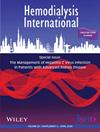中心血液透析单位患者远程医疗体验
IF 1.2
4区 医学
Q3 UROLOGY & NEPHROLOGY
引用次数: 0
摘要
本文章由计算机程序翻译,如有差异,请以英文原文为准。

In-center hemodialysis unit patient experience with telehealth
To the Editor Centers for Medicare and Medicaid Services (CMS) issued a series of telehealth waivers in 2020 that lifted geographic restrictions and expanded originating sites to include the home and dialysis units. For the first time, all nephrology practitioners in the United States could conduct in-center hemodialysis patient visits through telehealth. We evaluated patient experiences with the use of telehealth by their nephrologist in hemodialysis. Hemodialysis patients from 2 units located in the District of Columbia completed a survey in July/August 2021 regarding the use of telehealth with their nephrologists during the COVID-19 pandemic. Telehealth was conducted while patients were receiving treatment in the dialysis unit, and the clinicians were in their home, office, or hospital. The nephrologist determined whether a telehealth visit occurred. During telehealth visits, renal dietitians facilitated videoconferencing by bringing to the chair-side a laptop or tablet installed with a Health Insurance Portability and Accountability Act (HIPAA) compliant video platform. According to the telepresenters, each session approximated 10 min, with a range of 5–60 min. The survey, with a response rate of 75%, reported 94 patients using telehealth while 54 patients did not. A p value of <0.05 was used to identify differences between patients who did and did not report receiving dialysis care via telehealth. Patient demographic characteristics, time on dialysis, education level, primary language, and risk factors of COVID-19 exposure and/or infection did not differ by the receipt of care via telehealth (Table S1). Using a Likert scale ranging from 1 to 10 (10 = extremely satisfied), patients reported an average telehealth satisfaction score of 8.0, with 42% of patients indicating the highest satisfaction rating and 74% indicating a score of 7 or higher (Figure 1). More than 90% of patients reported spending enough time with their physician during their virtual visits and most patients did not report concerns regarding internet security (85%), privacy (85%), or technical issues (92%).
求助全文
通过发布文献求助,成功后即可免费获取论文全文。
去求助
来源期刊

Hemodialysis International
UROLOGY & NEPHROLOGY-
CiteScore
2.50
自引率
0.00%
发文量
58
审稿时长
6-12 weeks
期刊介绍:
Hemodialysis International was originally an annual publication containing the Proceedings of the International Symposium on Hemodialysis held in conjunction with the Annual Dialysis Conference. Since 2003, Hemodialysis International is published quarterly and contains original papers on clinical and experimental topics related to dialysis in addition to the Annual Dialysis Conference supplement. This journal is a must-have for nephrologists, nurses, and technicians worldwide. Quarterly issues of Hemodialysis International are included with your membership to the International Society for Hemodialysis.
The journal contains original articles, review articles, and commentary to keep readers completely updated in the field of hemodialysis. Edited by international and multidisciplinary experts, Hemodialysis International disseminates critical information in the field.
 求助内容:
求助内容: 应助结果提醒方式:
应助结果提醒方式:


